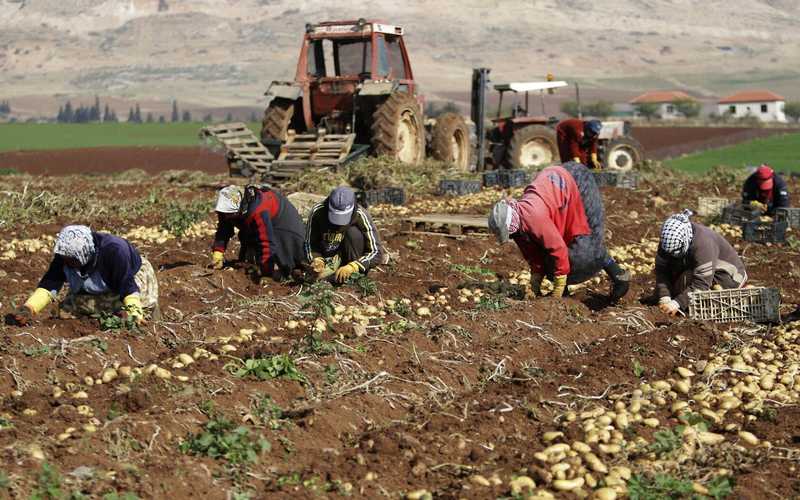
In the wake of October 7th, 2023, the Israeli military revoked the work permits of Palestinians from the West Bank and Gaza Strip who were employed in the Israeli economy. This move impacted roughly 160,000 workers in the West Bank – nearly 20% of its entire workforce. Additionally, an estimated 50,000 undocumented laborers lost work due to heightened restrictions on their movement. Around 20,000 Gazan workers were affected in the same fashion (1). This decision has caused significant harm to workers and their families, as they lost their source of income. It has also harmed the Palestinian economy, which faces ongoing challenges due to violence, destruction, siege, and restrictions on the movement of people, goods, and capital.
In this context, the Israeli authorities have announced that they are working on finding an alternative – importing foreign workers, specifically Asians. However, there are indications that the hurried recruitment campaigns conducted in India will not be able to replace the Palestinian workers either in the short or the long run. On the Israeli side, the security systems are well aware of the risk of “explosion” resulting from the economic deterioration in the West Bank. There are ongoing heated discussions in the Knesset regarding the fate of Palestinian workers and the terms of reemploying them. On the Palestinian side, many are expecting a gradual return to work in the Israeli economy similar to those that followed the first and second Intifadas.
The Paris Protocol of the Oslo Accords of 1994 characterizes this phenomenon simply in terms of the movement of labor between two adjacent economies. Once again, the neoliberal narrative adopted by states and international organizations affords this “mobility” a positive connotation and describes it as a better allocation of human resources and skills at the cross-border macroeconomic level, contributing to the workers’ aspiration for liberation and social progress at the individual level. In reality this “labor mobility” narrative is merely an enhanced variety of “labor market flexibility” and “cost reduction” policies that benefit the employer. As this mobility is subject to the needs of economic activity based on very restricted employment models, combined with administrative fragility, geographic and social isolation, and dependence on the employer, it deprives the workers of access to the most basic rights.
Such subordination and vulnerability of workers become crystal clear in the Palestinian context; as the “movement of labor” is part of a system of plunder, exploitation, and oppression practised by Israel against a whole nation. The Israeli military administration never coordinated with the Palestinian Ministry of Labor to issue work permits in accordance with the stipulations of the signed agreements in the first place. This is not a relationship that follows the law of supply and demand as economists imagine it. The ever-mounting difficulties faced by Palestinian workers who have been kept from working over the past few months, in addition to the development of this growing crisis, call for us to review the history of this phenomenon and its challenges.
In the jaws of ethnic cleansing and economic exploitation
Until 1948, Zionists used economic takeover as one of the most effective methods to change the demography in Palestine for the benefit of incoming Jews and ensure their control over the lands. In practice this was achieved through the formation of Jewish economic pockets under the slogan “Jewish Labor” and by supporting Zionist-run kibbutzim, as well as encouraging the hiring of Jewish workers by British or Jewish employers. The General Organization of Workers in Israel (Histadrut), formed in 1920, went as far as recruiting the “Labor Watch” whose activities included patrolling construction sites and factories, terrorizing workers and employers, and forcing employers to fire Arab workers in order to hire Jewish settlers (2).
This represents a significant trait of settler colonialism, which seeks to replace natives with settlers: in this case without fully discarding a Palestinian workforce that receives much lower pay than the Jewish workforce and can be given lower-value employment.
The employment of Palestinian workers in the Israeli economy has been historically used as an example of the Zionist occupation’s positive impact on the Arab economy. The perspective promoted today in talks about Palestinian workers employed in the Israeli economy completely ignores the fact that British power and the Zionist movement monopolized the country and its resources by force. The expansion of the Jewish economy – resulting from the continuous confiscations of property and the means of production, – turned the Palestinian producers into cheap available labor.
This colonial path continued after 1948, as well as 1967. The occupation of the West Bank and Gaza Strip, the establishment of Israeli settlements, the confiscation of lands and resources, and increased border control, alongside multiple decades of military administration control on economic policies, changed the economic fabric of these lands and resulted in a dangerous deterioration. These practices align with very similar policies applied to what are called “Interior Palestinians”. Israel is not only working to control natural resources but also to increase policies of economic dependency that allow it to exploit the consumer market, capital, and Palestinian labor to its advantage.
A reliable source of cheap labor
The presence of Palestinian labor compensates for the shortage of Israeli workforce in terms of economic need, specific activities, and specific sectors. This is controlled by the military administration, which issues movement and work permits. This phenomenon expanded rapidly during the 1970s and 1980s to the point where a third of the Palestinian workforce had been hired in the Israeli economy. That was the general situation before the first intifada in the late 80s, that brought with it an economic boycott by Palestinians, leading Israel to significantly reduce the number of Palestinian workers, temporarily replacing them with Asian labor.
The phenomenon of reliance on Palestinian labor from the West Bank made a significant return 15 years ago and has expanded in the last two years into the Gaza Strip in spite of the siege. One of the reasons for this comeback is the Palestinians’ knowledge and experience of the language and work conditions of the Israeli economy. They are familiar with dealing with Israeli employers and customers. Additionally, Israeli employers may need to provide accommodation for workers coming from other countries while the Palestinian workers from occupied territories have homes to go back to every night. Finally, from a pure economic point of view the Palestinian workers spend their wages locally within a Palestinian economy that is little more than an appendage of the Israeli economy.
The utter collapse of the Palestinian economy, mass unemployment, and the impoverishment of the population in the last decade turned Palestinians into a ready source of cheap labor for the Israeli economy. Estimates showed that a Palestinian worker is paid 50-75 % that of an Israeli worker for the same job. The Palestinian work force is mainly deployed in jobs require no skills, or limited skills, such as construction, agriculture, hotels, and restaurants, and in jobs that do not require technological skills, despite an increase in recent years of qualified Palestinian workers employed in medical care, engineering, and tech on a much smaller scale.
Employment dependency for control and compliance.
The employment of Palestinian workers aligns with an approach of exploiting the local workforce and it has also proven to be an effective tool for control and domination. Over the years, the Israeli military administration developed its own system to regulate the Palestinian workforce, not only as a response to ever-changing economical requirements but also for reasons of “security” and “intelligence”. It built infrastructure such as crossing points, special gates, and a digital database, and put in place procedures for issuing work permits and security checks while imposing surveillance and tight control(4).
Since the end of 2016, this administration has implemented a new system that requires Palestinian workers to register their job applications via an electronic platform. On this platform, job seekers must fill out a form detailing their personal information and professional experience. They then undergo a security check before being linked to an employer and receiving their “approval”. Finally, they may need to apply for a work permit (5), in the knowledge that the Israeli security service or employer can cancel these permits at any time.
This continuous and strict supervision of the Palestinian workforce within the Israeli economy, which is always temporary, is precisely what renders it more available and ready for work. This imposed system goes beyond a professional relationship in the workplace by allowing for sanctions on any worker participating in a union or any political activity. Families and whole villages in the West Bank are always careful not to become the target of a “security ban” for fear of losing their Israeli work permits.
Exposure to harm and abuse
Palestinians working in the Israeli economy remain exposed to danger, discrimination, and abuse. According to a recent report from the International Labor Organization, the number of workplace accidents and deaths on construction sites has reached one of the highest rates in the world, along with poor working conditions, unsafe and potentially dangerous activities, a lack of social protection, and daily violence. Moving between home and work is often punctuated by long periods of waiting at Israeli checkpoints and the risk of recurrent confrontations with army members or settlers.
With the permit system in place, an alternative way to obtain a work permit through intermediaries or brokers has emerged as a parallel to the system. It is estimated that nearly 30,000 workers were employed in 2022 using the services of such intermediaries, in exchange for an average remuneration of nearly 2,500 shekels (US$650) per month, (6) which can represent one third of a salary. On the other hand, around 50,000 workers who lack permits or contracts travel to their workplaces, bypassing the Israeli surveillance system. This creates a remarkable phenomenon in West Bank settlements: a workforce forced to resort to "fraud" becomes particularly vulnerable to danger, abuse, and exploitation.
A recently published study by the Al-Haq Foundation indicated that these workers receive lower wages, work longer hours, and rarely receive vacation time. They also work in intensive industrial or agricultural activities or handle dangerous materials without any protection, leaving them exposed to accidents and diseases. (7) This workforce is partly made up of children, whose number is estimated between 500 and 1,000, and who are exploited in the agricultural colonies of the Jordan Valley. (8) The lack of supervision and protection exposes these children to the most serious forms of exploitation and abuse, and constitutes a direct threat to their health and safety.
Hegemony, not economic integration
While the cancellation of work permits and the dismissal of large numbers of Palestinian workers has raised many concerns about the fate of workers and the economic difficulties plaguing the West Bank, this does not contradict the retention of certain permits or the return of Palestinian workers in recent weeks in certain sectors and in certain regions.
Although this applies to a very small number of workers, it demonstrates the importance of this vulnerable, exploitable, and replaceable workforce for Israeli employers. The Palestinian workforce differs from other “mobile” labor forces in that it is neither migrant nor expatriate, but rather colonized. The organization of its existence goes beyond the fluctuations in supply and demand for labor in the Israeli and Palestinian markets, forming the basis of a colonial domination exercised over an entire nation. The efforts made by certain international parties under the pretext of improving "integration" between the Israeli and Palestinian economies, while turning a blind eye to the context of colonial occupation, only legitimize and strengthen Israeli economic hegemony over the Palestinian economy. This specificity of the Palestinian case does not make it an exceptional case; on the contrary, it should encourage us to think about all forms of domination that can be covered up by the phenomenon of labor “mobility”.
Taher Al-Labadi, Researcher at the French Institute of the Middle East in Jerusalem.
Ghida Yemen - Holder of bachelor's degree in computer and communications engineering and a master's degree in business administration from the American University of Beirut. Currently works in translation and freelance writing.
References:
1 Institute of Palestinian Economics (MAS), 2023, On the economic and social impact of war on Gaza Strip, Economic Report on the war on Gaza, issue no. 4, Ramallah.Taher Labadi, 2024, “ How Israel Dominates the Palestinian Economy” , Jacobin, (https://jacobin.com/2024/01/israel-palestine-settler-colonialism-labor-economy)Its percentage in the West Bank reached 13% and 46% of the working population in the Gaza Strip in 2022, noting that a large portion of them are already working in the Israeli economy.Walid Habbas, 2023, « Palestinian Workers in Israel: Brokering and Transformations in the Work Permit System », MAS Economic Monitor, Ramallah.Same sourceSame sourceAl-Haq, 2021, Captive Markets, Captive Lives | Palestinian Workers in Israeli Settlements, Ramallah.MA'AN Development Center, 2012, Palestinian Child Laborers in Agricultural Settlements in the Jordan Valley, Ramallah.
``






